
History of the Synth |
| Synthesizer | Type of Synthesis | Year | Link |
|---|---|---|---|
| Telharmonium | Tone Wheel, No Amplifier | 1897 | Wikipedia |
| Hammond Organ | Tone Wheel, With Amplifier | 1935 | Wikipedia |
| Moog Synthesizer | Pure Analog | 1964 | Wikipedia |
| Mini Moog | Pure Analog | 1970 | Wikipedia |
| Yamaha DX7 | FM Synthesis | 1983 | Wikipedia |
| Roland D50 | PCM | 1987 | Wikipedia |
| Korg M1 | Sampler, Rompler | 1988 | Wikipedia |
| Nord Lead | Analog modeling | 1995 | Wikipedia |
Telharmonium (1897)
Tone Wheel, No Amplifier
Originally I was going to skip mentioning this because it's not that relevant to todays equipment but the more I read about it the more I realized that both the Telharmonium and the Hammond Organ are great instruments to learn about how music is created.
At their most basic level both use "Tone wheels".
Electromagnetism 101
If you move a magnet near a coil of wire, you generate an electric current. The genius of the tone wheel was to use a wheel with "gears" and spin this near the coil of wire. As the tip of the gear gets closer to the coil, the electricity generated gets stronger, and the farther away the tip goes the less. By spinning the wheel you generate a variable electrical signal. If you change the number of gears or the rate they spin, you get different pitches. If you change the shape of the teeth on the gear, you generate different tones like sine waves or saw tooth waves.
I love how this is a very visual way to see how the sound is being made physically and how the sound looks on an oscilloscope.
It's limitation was the lack of an amplifier. Or more accurately, the amplifier had not been invented yet. This meant that you had to generate a very large electrical signal and you needed very large wheels. Very large as in his first model weighed 14,000 lbs. This was just a starting point as his later models (shown) below were designed to transmit the signal over telephone wires and were according up sized.
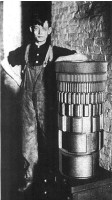
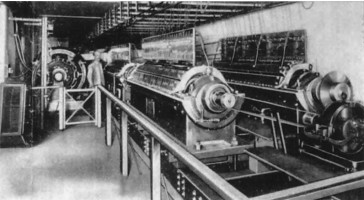
Tone Wheels Article on Wikipedia
Wikipedia
If you are interested in more about the Telharmonium, there are a bunch of great videos on YouTube.
Hammond Organ (1935)
Tone Wheel, with Amplifier
With the invention of the electronic amplifier, it was possible to reduce the size required to make a synthesizer from the city block sized Telharmonium to something more like a piano. It still used physical tone wheels and it still had an incredible number of moving parts, but it was portable and even had some basic modulation options with the drawbars that could change the sound and tone on the fly.
If you are interested in the mechanics I highly recommend the YouTube video "Hammond Organ Tone Generator" below. I find it a remarkable piece of mechanical engineering.
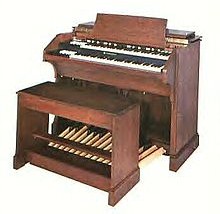
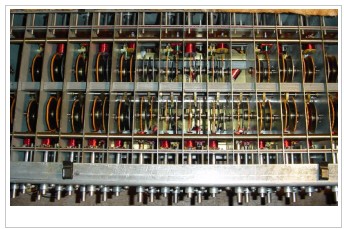
What does it sound like?
Here we need to add some complication. Unique to the Hammond Organ sound that became popular is the "Leslie speaker". Most of the music you find is made using the Leslie speaker and it has a very distinctive sound, but that is not the speaker that was originally sold in the Hammond organ. The Leslie speaker is not only a digital amplifier, but the speaker physically rotates. It was made to better approximate the sound of a pipe organ but became "the sound" of the Hammond Organ for all types of music.
Booker T Jones - Green Onions on NPR
(Most likely Not a Leslie speaker)
YouTube Link
Joe Pantano Killing it on the Hammond Organ - A-100 Restoration by Retrolinear
(Leslie speaker + Leslie speaker simulated)
YouTube Link
Leslie speaker
Wikipedia Article
Wikipedia
Neo Instruments Ventilator review (Leslie 122 simulator)
YouTube Link
In Popular Music
Procol Harum - Whiter Shade of Pale
YouTube Link
Boston - Foreplay/Long Time (Hammond M-3 organ)
YouTube Link
Carlos Santana - Oye Como Va (Hammond B-3 organ)
YouTube Link
And more
The Doors - Light My Fire
Emerson, Lake & Palmer - Karn Evil 9 - 1st Impression - Part 2
Animals - The House Of The Rising Sun
More about the Organ
Hammond Organ History
YouTube Link
Hammond Organ Tone Generator
YouTube Link
Moog Synthesizer (1964)
Analog, Subtractive Synthesis, Monophonic, Monotimbral.
Considered to be the first electronic synthesizer. Or specifically the first commercially available "modular voltage-controlled analog synthesizer". The sound was created via an electric current that was modulated and filtered by "modules". The user could connect these modules in any order they wished to create new and different sounds.
It had a big rich sound but was also huge, unwieldly, and so expensive as to take it out of the realm of most musicians. It also could only play one note at a time, so no chords.
It makes more sense if you look at a picture. Notice that the unit is made from many sub models and that to connect the models to each other you would literally connect them with patch cords from one model to the next.
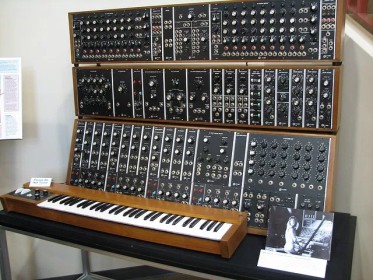
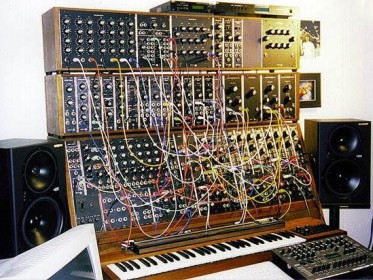
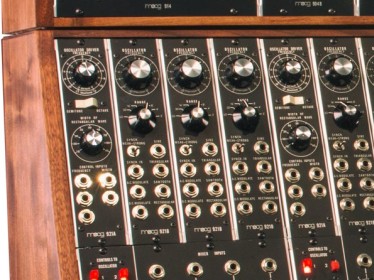
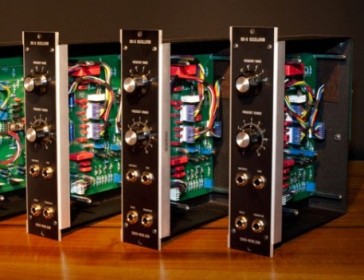
What does it sound like and how do you use it?
Moog System 55 Modular Synth - Sweetwater Exclusive Preview
YouTube Link
Exploring The Original R.A. MOOG Modular Synthesizer System
YouTube Link
In Popular Music
Lucky Man by Emerson Lake & Palmer:
Solo starts at 3:20
YouTube Link
The Doors - Strange days
YouTube Link
Donna Summer – “I Feel Love”
YouTube Link
Switched on Bach
Note: Since the Moog only plays one note at a time, this is a 4 track recording.
YouTube Link
Mini Moog (1970)
Analog, Subtractive Synthesis, Monophonic, Monotimbral.
Jump forward 14 years to 1970 and the release of the Mini Moog. Still using analog subtractive Synthesis and very similar to the original Moog, but now it's portable and affordable. It's no longer modular, but this removes the need for patch cables. It's also much smaller and suitable to take on the road for live shows. It's still an analog synthesizer and still only plays one note at a time. It's also insanely popular.
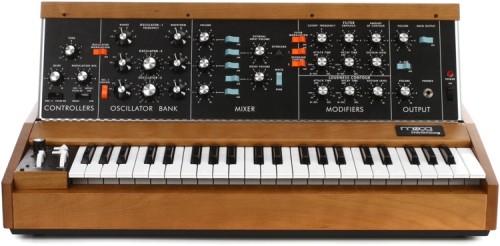
History
A Brief History of the Minimoog Part I
YouTube Link
What does it sound like
The Mini Moog sound
YouTube Link
In Popular Music
Shine On You Crazy Diamond
YouTube Link
Whip It - Devo
YouTube Link
Bob Marley’s Reggae classic “Stir It Up”
YouTube Link
Yamaha DX7 (1983)
Digital, FM Synthesis, 16 voice Polyphonic, Monotimbral
Jump forward another 13 years and say hello to digital. This is when the pace of change skyrockets. First we have Yamaha DX7. Using Digital FM (Frequency Modulation) Synthesis. The sound is created Digitally, and instead of subtracting frequencies to make new sounds, you modify the sound to add complexity. It's digital so you get the benefit of consistency which is no small benefit to the traveling musician on tour. Add another great improvement with the ability to play 16 Notes at a time and some great predefined sounds and you have a winner.

In Popular Music
Bobby at "Bobby Blues" already made an excellent web page on this, Just go here.
Bobby Blues
If for some reason Bobby's site goes down here are few he mentions
Chicago "17", "Hard Habit To Break"
Luther Vandross, "Here And Now"
Queen "A Kind Of Magic"
Roland D50 (1987)
Digital, PCM/Looping, 16 voice Polyphonic, 2 part Multi-timbral.
Only 4 years later and Roland would develop "Linear Arithmetic synthesis" Which is another way to say they used PCM and Looping. By using very small samples to start the sound and then ending with standard synthesizer sounds they were able to use less ROM memory lowering the cost and increasing realism. As a side note, this is also why there are no exact reproductions of this synth as VST's. While you can't copy write how to make an analog sound, you can copyright a sample and the PCM samples were and are under copy write.
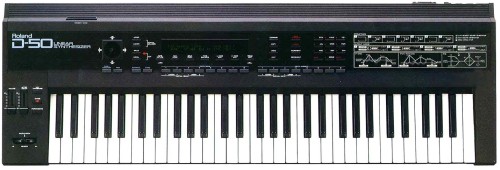
In Popular Music
Bobby at "Bobby Blues" already made an excellent web page on this, Just go here.
Bobby Blues
If for some reason Bobby's site goes down here are few he mentions
Enya "Watermark" (pizzicato strings)
Jean Michel Jarre "Révolutions" (Everything)
Paula Abdul "Forever Your Girl" (Trumpets)
Chicago "19"
Korg M1 (1988)
Digital, Sampler, 16 voice Polyphonic, 8 part Multi-timbral.
Just 1 year later Korg released the M1. Korg's answer to the D-50, they added a sequencer and full 8 part multi-timbral specs to make the first Keyboard/sequencer where you could create multipart songs. The sampled clips were longer than the D-50 so some people draw the line here and call it a sampler or rompler but it's a fine line. In either case they further blurred lines between sampler and synth.

In Popular Music
Bobby at "Bobby Blues" already made an excellent web page on this, Just go here.
Bobby Blues
If for some reason Bobby's site goes down here are few he mentions
Queen "Don’t try so hard" (synth pad)
Robin S - Show Me Love
Seinfeld Theme Song
Nord Lead (1995)
Digital with Analog Modeling, 4 voice Polyphonic, 4 part Multi-timbral.
Also called the "Clavia Nord Lead". This was the first Digital synthesizer that tried to emulate the sound of an analog synthesizer. In their own words "Using Virtual Sound Modeling technology the intricate nuances and character of analog synth sounds".

What does it sound like?
JD73 Nord Lead 4 Sound Bank Demo.
YouTube Link
In Popular Music
No idea. I pretty sure this was used in lots of "house dance music" but I could find absolutely nothing about it. Strange as it's an extremely well known synth and the tech is referenced everywhere. My best two guesses are either that it 1) It was made to sound like everything else, so it has no "classic sound of its own" or 2) It's not old enough to get the nostalgia treatment and in 10 years I'll see lots of web pages and videos about how great it was and exactly where it was used.
Jarre's Oxygene Part 2 Sequenced on a Nord Lead A1
YouTube Link
Yamaha S-YXG50 (1997)
Steinberg Neon (1999)
Digital. Infinite Polyphonic, Infinite Multi-timbral
This is the beginning of the end for the hardware synth and where things go from murky to downright opaque when you try to find out how did this turn into the VST's of today. In the category of what is the first VST synthesizer, the answer is "it depends on how you define VST". The two major front runners are the Yamaha and the Steinberg.
Yamaha S-YXG50
Definitely first, but more of a replacement to the standard Microsoft MIDI player. It is worlds beyond the sound of the standard MIDI player of 1997, but it's not even close to the sounds of the synthesizers of the era.
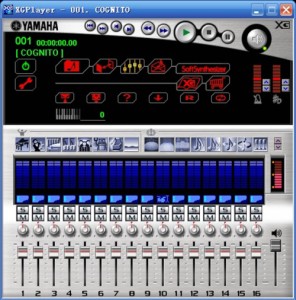
What does it sound like?
Yamaha S-YXG50
YouTube Link
In Popular Music
Nope. This was not used in popular music. While it was worlds better than the IBM PC audio of the time, this was not made for commercial music.
Steinberg Neon (1999)
The Steinberg Neon (1999) came included with Cubase VST 3.7 and sports two oscillators, ADSR envelopes, an LFO and a resonant filter. This definitely what you think of when you think VST. It's not all that interesting, but it's a program that runs as a virtual synthesizer.

What does it sound like?
Neon by Steinberg
YouTube Link
In Popular Music
Nope. This is still not up to par with dedicated hardware. But it started to show that it was only a matter of time before VST's were the future.
And After (2000+)
And here the trail run's cold. For the next decade the quality of Virtual Synths steadily increased and simultaneously there was a steady stream of new hardware based synths. Exactly where the crossover occurred and musicians started to actually use the virtual synths in their music is unknown.
From "A history of the Synth from Gizmodo"
Gizmodo
"The pendulum swung back again when the rise of super affordable software synths (“softsyths”) meant anyone with a laptop could be a producer or pump out EDM to dance floors at da club".
